The Intel SSD 330 Review (60GB, 120GB, 180GB)
by Anand Lal Shimpi on August 1, 2012 12:01 AM ESTAnandTech Storage Bench 2011
Two years ago we introduced our AnandTech Storage Bench, a suite of benchmarks that took traces of real OS/application usage and played them back in a repeatable manner. I assembled the traces myself out of frustration with the majority of what we have today in terms of SSD benchmarks.
Although the AnandTech Storage Bench tests did a good job of characterizing SSD performance, they weren't stressful enough. All of the tests performed less than 10GB of reads/writes and typically involved only 4GB of writes specifically. That's not even enough exceed the spare area on most SSDs. Most canned SSD benchmarks don't even come close to writing a single gigabyte of data, but that doesn't mean that simply writing 4GB is acceptable.
Originally I kept the benchmarks short enough that they wouldn't be a burden to run (~30 minutes) but long enough that they were representative of what a power user might do with their system.
Not too long ago I tweeted that I had created what I referred to as the Mother of All SSD Benchmarks (MOASB). Rather than only writing 4GB of data to the drive, this benchmark writes 106.32GB. It's the load you'd put on a drive after nearly two weeks of constant usage. And it takes a *long* time to run.
1) The MOASB, officially called AnandTech Storage Bench 2011 - Heavy Workload, mainly focuses on the times when your I/O activity is the highest. There is a lot of downloading and application installing that happens during the course of this test. My thinking was that it's during application installs, file copies, downloading and multitasking with all of this that you can really notice performance differences between drives.
2) I tried to cover as many bases as possible with the software I incorporated into this test. There's a lot of photo editing in Photoshop, HTML editing in Dreamweaver, web browsing, game playing/level loading (Starcraft II & WoW are both a part of the test) as well as general use stuff (application installing, virus scanning). I included a large amount of email downloading, document creation and editing as well. To top it all off I even use Visual Studio 2008 to build Chromium during the test.
The test has 2,168,893 read operations and 1,783,447 write operations. The IO breakdown is as follows:
| AnandTech Storage Bench 2011 - Heavy Workload IO Breakdown | ||||
| IO Size | % of Total | |||
| 4KB | 28% | |||
| 16KB | 10% | |||
| 32KB | 10% | |||
| 64KB | 4% | |||
Only 42% of all operations are sequential, the rest range from pseudo to fully random (with most falling in the pseudo-random category). Average queue depth is 4.625 IOs, with 59% of operations taking place in an IO queue of 1.
Many of you have asked for a better way to really characterize performance. Simply looking at IOPS doesn't really say much. As a result I'm going to be presenting Storage Bench 2011 data in a slightly different way. We'll have performance represented as Average MB/s, with higher numbers being better. At the same time I'll be reporting how long the SSD was busy while running this test. These disk busy graphs will show you exactly how much time was shaved off by using a faster drive vs. a slower one during the course of this test. Finally, I will also break out performance into reads, writes and combined. The reason I do this is to help balance out the fact that this test is unusually write intensive, which can often hide the benefits of a drive with good read performance.
There's also a new light workload for 2011. This is a far more reasonable, typical every day use case benchmark. Lots of web browsing, photo editing (but with a greater focus on photo consumption), video playback as well as some application installs and gaming. This test isn't nearly as write intensive as the MOASB but it's still multiple times more write intensive than what we were running in 2010.
As always I don't believe that these two benchmarks alone are enough to characterize the performance of a drive, but hopefully along with the rest of our tests they will help provide a better idea.
The testbed for Storage Bench 2011 has changed as well. We're now using a Sandy Bridge platform with full 6Gbps support for these tests.
AnandTech Storage Bench 2011 - Heavy Workload
We'll start out by looking at average data rate throughout our new heavy workload test:
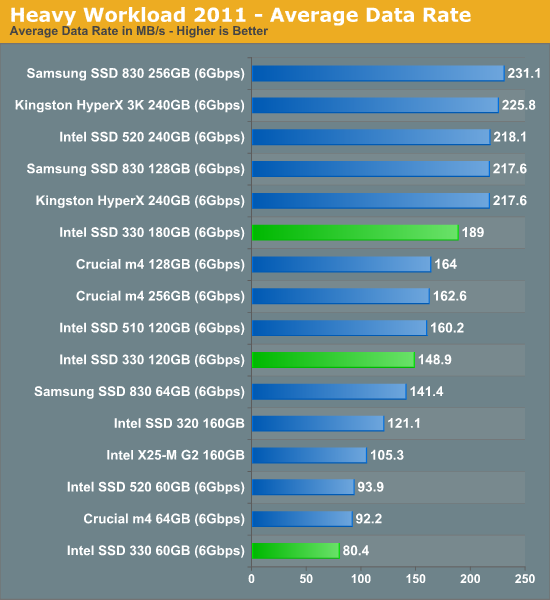
Our heavy storage bench suite shows average performance for Intel's SSD 330. There's a bit of a gap between it and the SSD 520 as well.
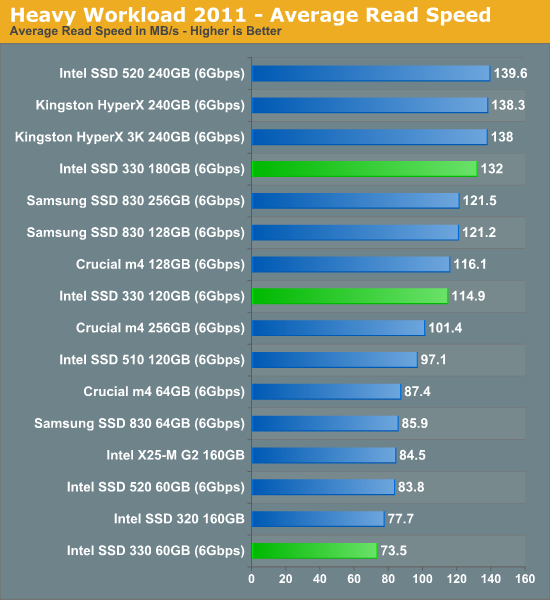
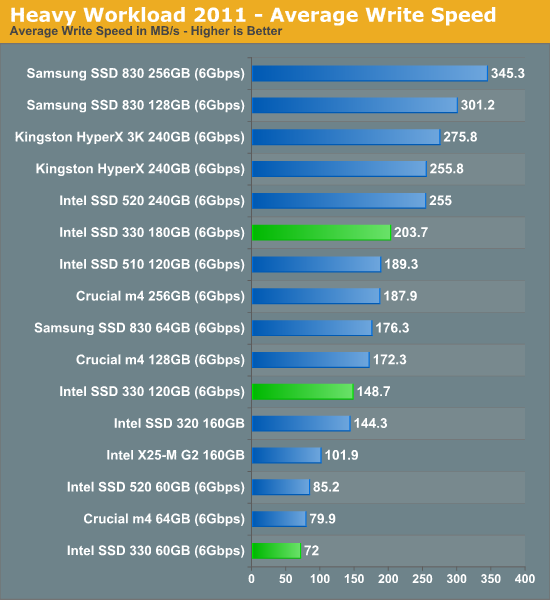
The next three charts just represent the same data, but in a different manner. Instead of looking at average data rate, we're looking at how long the disk was busy for during this entire test. Note that disk busy time excludes any and all idles, this is just how long the SSD was busy doing something:
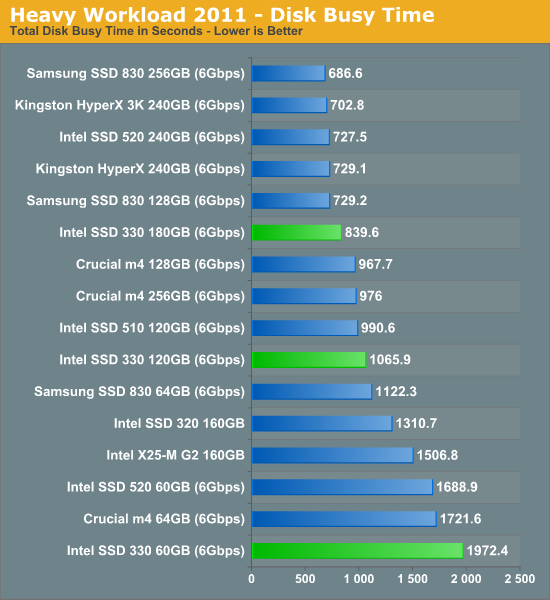
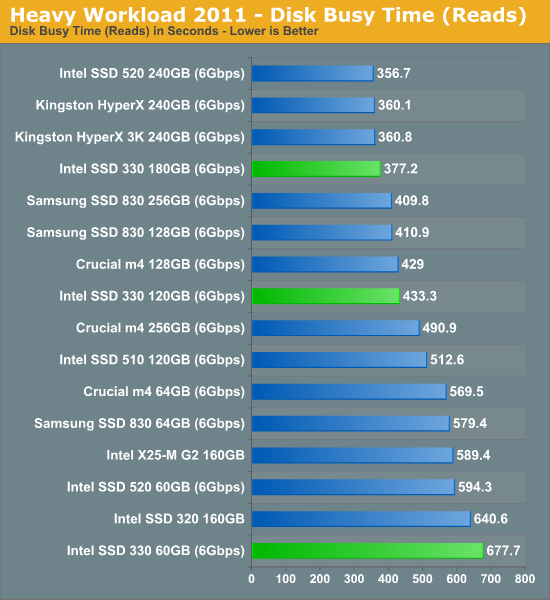
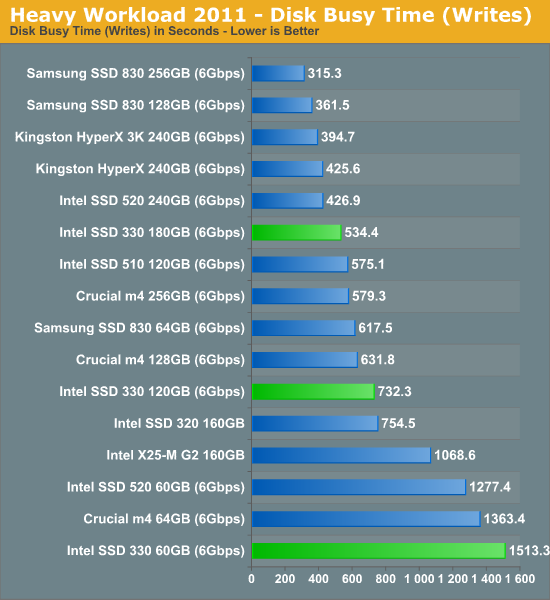










64 Comments
View All Comments
Lacrimosa - Saturday, September 15, 2012 - link
Hello,Good review. I had been looking for Intel 330 for my laptop. I would like to have the data encrypted though and according to this review the 330 is not a good option for me then. What are the good comparable options then? Reliability and ability to encrypt are the qualities I would be looking for and it would be nice if the price weren't too high either.
P_Turner - Monday, December 3, 2012 - link
I've just RMA'd an Intel 330 SSD 180 GB back to Newegg. I get a BSOD on each and every resume from sleep. Unfortunately, Newegg won't issue refunds for this SSD (a Cyber Monday special), although they will process an RMA if you pay for the shipping.Be sure to read the Intel SSD forum BEFORE the purchase. Lots of complaints over BSODs on the 330 and 520. Worse, the complaints are just ignored by Intel.
Just my opinion, but all Sandforce based SSDs are obsolete from the get go. It's also my opinion that a big name on the label means nothing if the company just blows off customer issues.
P_Turner - Sunday, December 30, 2012 - link
The new Intel 330 180 GB that Newegg sent me was the same as the one I RMA'd. Same BSOD issue, 100% repeatable. So the question at this point was: is my Asus x83-vb laptop incompatible with SSDs?To answer the question, I pulled my 64 GB Crucial M4 out of my desktop, where it is the OS and program disk. Of course, I imaged the M4 first. The M4 then went into my Asus x83-vb after a secure erase.
The result was that the Crucial M4 was flawless. Newegg has relented and is allowing me to return the Intel 330 for store credit in the form of an e-gift card.
I've ordered a 256 gb M4 from Newegg, and I will post the results -- good or bad -- provided that posts to this article remain open. It could be that the Asus's BIOS doesn't allow an SSD larger than 64 GB or it could be that I just got lucky with my old M4. I'll know in two weeks.
ghabhaducha - Saturday, January 5, 2013 - link
Hi Anand,Thanks for such an awesome review of drives, clearly you have a talent for journalism.
After reading the extensive information you have on SSDs at Anandtech, I decided to purchase 2x Intel 330 240GB for the purposes of RAID0. Now, the way I understood it, the 180GB model uses 12x "29f16b08ccme2" Intel 16GB 25nm NAND flash, which based on your reviews, is also used by the OCZ Vertex 3 240GB and Kingston HyperX 240GB. I was curious if the Intel 330 240GB used the same "29f16b08ccme2" flash OR does it use the "29f16b08ccme3" flash that is used in the Kingston HyperX 3k? I really didn't want pry open my SSDs and void the warranty, but I was curious if you had documented this during your reviews.
Thanks,
ghabhaducha